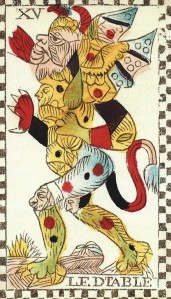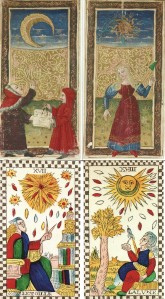Gerard Bodet Tarot Restored by Sullivan Hismans
The Gerard Bodet Tarot restored by Sullivan Hismans (Tarot Sheet Revival) may be the oldest complete Rouen-Brussels deck we have. Around the year 1500, tarot migrated from Italy to France and entered a new phase of development. Milanese tarot swept across Europe, becoming the standard gaming deck and evolving into the Tarot de Marseille pattern. An alternate style migrated from Florence and Ferrara, then lurked underground until surfacing in Paris in the mid-seventeenth century as the Jacques Vieville deck, a hybrid of the Tarot de Marseille and Rouen-Brussels patterns. Let’s look at what’s distinctive about this style and where Bodet’s deck fits in with its development. (All cards in this article are Gerard Bodet unless stated otherwise.)
The Rouen-Brussels Pattern
Several Rouen-Brussels trump cards deviate from the standard Tarot de Marseille pattern. The Spanish Captain and Bacus replace the Papesse and Pope. The Devil (top of page) closely resembles the distinctive Bolognese devil. The Hanged Man stands upright. His fingers stick up from behind his shoulders as in Tarot de Marseille Type I cards. The Tower is called La Foudre (Thunderbolt) and depicts a shepherd sheltering under a tree. The Chariot (not shown) is in profile and pulled by one horse. Temperance (not shown) has a banner inscribed with the words Fama Sol, which could be translated as “Only Fame”, or “Fame Alone.” This may be a nod to Petrarch’s poem I Trionfi, where Fame triumphs over Death; while in the trump sequence, Temperance ranks higher than Death. Trumps XVII to XXI in the Rouen-Brussels pattern are influenced by Florentine precedents.
The Italian Connection
The so-called Charles VI Tarot, painted for a wealthy patron in mid-fifteenth century Florence, was acquired by a tutor in the court of King Louis XIV of France. The tutor died very early in the eighteenth century and left the deck to what is now the Bibliothèque Nationale de France. These distinctive cards could have influenced Parisian artists and deck creators.
The Astronomers with their calipers in the Italian deck inspired the seated astronomer in the Rouen-Brussels Star card. The standing woman with a spindle on the Charles VI Sun card becomes a seated woman with a spindle on The Rouen-Brussels Moon card. Florentine Judgment and World cards (not illustrated) influenced some of the details in Rouen-Brussels cards.
Four Rouen-Brussels Tarot Decks
Four decks in this pattern have been restored and are available today. I’ll compare the four in my collection, using the Lovers card to highlight the differences.
The oldest deck is by Jacques Vieville (upper left) whose mid-seventeenth century print shop was in the same Parisian neighborhood as Jean Noblet and the printer of the Anonymous Tarot de Paris. This deck is a hybrid of the Rouen-Brussels and Tarot de Marseille patterns. It has the traditional Pope and Papesse, as well as Chariot and World cards that conform to the Tarot de Marseille. Trumps XIV through XX are in the Rouen-Brussels style.
The Gerard Bodet Tarot (upper right) is the oldest complete deck of this style, and the only complete deck from the 17th century. Only one copy exists in a Belgian museum. Bodet was known to be active in Liège in the 1690s. The lines and general drawing style are very similar to the Vieville. Compare the placement of the hands, especially the oddly placed left arm of the central figure, and the angle of his legs. It seems that Bodet copied a Vieville deck, or they are both derived from a common ancestor.
The de Hautot (bottom left) family of card makers was active in Rouen for several generations. There were at least three card makers named Adam de Hautot, but the probable printer of this deck was active from 1723 to 1748. The deck has several unusual features. The Emperor and Empress have switched places. The Hanged Man has a rope sticking out of the top of his head. In the Judgment card, several people, including a skeleton, pop out of their graves. The Fool is numbered XXII. This deck is considered a bridge between the hybrid Vieville and later standard decks of this pattern like the Vandenborre.
The Vandenborre deck, printed in Brussels in 1762, is the most recent and most polished deck of this style. Cartes de Suisses printed on the Ace of Coins possibly indicates this deck was made for export. Several Belgian printers, like Dupont, Jar and Galler, made decks very similar to Vandenborre in the mid-eighteenth century. These are illustrated in Kaplan’s Encyclopedias.
Unique Features of the Bodet Tarot
Pages and Knights are called Valet and Chevalier in all suits except Cups where they are labeled Varlet and Vale. The Ace of Cups looks more like the Tarot de Marseille than the globular Rouen-Brussels cup. The Two of Cups has the same inscription found in other decks of this type, reminding game players that the lower numbered Cups and Coins rank higher than the high numbers. The Swords pip cards have elaborate central details.
About the Deck
The deck was printed in a limited edition of 400. The cards are 2.75 x 5.0 inches (12.4 x 7.0 cm) with printed checkered borders that imitate the folded borders of Italian decks. The smooth, lightly coated card stock is a delight to shuffle. The deck is packaged in a sturdy envelope stenciled with original art by Hismans. The Tarot Sheet Revival website linked below will take you to more images of the cards and their packaging, along with technical details.

Links
Tarot Sheet Revival – see more photos of the envelope and cards, and purchase the deck.
https://www.tarotsheetrevival.com/en/product/gerard-bodet-tarot/
Video by Justin Michael comparing the four decks discussed in this article
https://www.youtube.com/watch?v=GiDKetyqcqw
My review of the Vandenborre deck restored by Pablo Robledo
https://tarot-heritage.com/2018/07/26/the-vandenborre-deck-restored-by-pablo-robledo/
An article on the Spanish Captain in tarot with some cultural background
https://tarot-heritage.com/2015/10/22/the-spanish-captain-in-the-vandenborre-deck/
Andy’s Playing Cards website – a page on the Rouen-Brussels pattern:
https://l-pollett.tripod.com/cards63.htm
Decks Illustrated in this Article
Gerard Bodet Tarot. Liège, Belgium, c. 1693. Restored by Sullivan Hismans, Tarot Sheet Revival, 2022.
Jacques Vievil Tarot. Paris c. 1650. Restored and hand painted by Sullivan Hismans, Tarot Sheet Revival, 2019.
Adam de Hautot Tarot. Rouen, early 18th century. Restored by Sullivan Hismans, Tarot Sheet Revival, 2020.
Vandenborre Tarot Flamand. Brussels, 1762. Restored by Pablo Robledo, 2018.
Charles VI Tarot. Florence, mid-15th century. Restored by Marco Cesare Benedetti, 2019.







Well written as always! My new favorite deck of beloved Belgian tradition. Looking forward to more articles. How about one on Bacchus? 🙂
That would be a fun article to write. There’s evidence that the Bacchus card has a link to the Bacchus Society, a drinking club for Flemish artists living in Rome in the 18th century. Their proceedings were known to be rowdy, lewd and profane and to involve an initiation stunt that required straddling a wine barrel while naked.
P. S. The Ace of Cups has 2 versions – original and restored. I use restored – it’s beautifully done by Sullivan Hismans and is as authentic as it gets, it fits right in.
I’m so glad you mentioned the second Ace of Cups card that comes with the deck. I really should have discussed it, but I’m always afraid my articles are too wordy as it is. It’s very lovely, and very TdM. I’m sure there’s an image on his Tarot Sheet Revival web page.
Lovely is a good word for it, I agree. The deck came with both versions – I wanted to make sure folks who are considering the deck are not deterred by the beaten up chalice – there is a beautiful Ace included alongside the “authentic” one.
Another highly informative and educational piece, there is so much to take in, but you write so well. Thank you.
Hello Francis, Thank you so much for your kind words. I’m glad you’re enjoying the website.